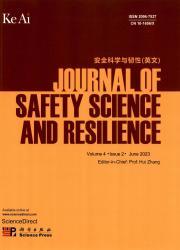Optimizing urban infrastructure resilience: Analyzing cascading failures and critical node dependencies through multilayer network models
IF 3.4
Q1 PUBLIC, ENVIRONMENTAL & OCCUPATIONAL HEALTH
引用次数: 0
Abstract
As urbanization and industrialization progress, urban infrastructure systems grow increasingly complex, heightening their vulnerability to cascading failures from natural disasters and human-induced disruptions. Strengthening the resilience of these systems is critical for sustainable urban development and sustaining residents’ quality of life. This study introduces a novel framework to analyze cascading failure propagation within infrastructure networks. Utilizing the implicit interdependency model, we construct a multilayer network that delineates interconnections and dependencies across infrastructure sectors. The PageRank algorithm is used to identify critical nodes by evaluating their network centrality, thereby highlighting key components within the system. Through simulations of random, PageRank-based, and betweenness-based attack scenarios, we explore failure dynamics and their propagation patterns. Additionally, we evaluate mitigation strategies, with the community periphery augmentation strategy proving most effective, enhancing resilience by linking peripheral nodes between communities. This research systematically connects the significance of key nodes to cascading effects, uncovering vulnerabilities and providing actionable insights for disaster response and recovery planning.
优化城市基础设施弹性:通过多层网络模型分析级联故障和关键节点依赖关系
随着城市化和工业化进程的推进,城市基础设施系统变得越来越复杂,更容易受到自然灾害和人为破坏的连锁故障的影响。加强这些系统的复原力对于可持续城市发展和维持居民的生活质量至关重要。本研究引入了一个新的框架来分析基础设施网络中的级联故障传播。利用隐式相互依赖模型,我们构建了一个多层网络,描绘了基础设施部门之间的相互联系和依赖关系。PageRank算法通过评估其网络中心性来识别关键节点,从而突出显示系统中的关键组件。通过模拟随机的、基于pagerank的和基于之间的攻击场景,我们探索了故障动态及其传播模式。此外,我们还评估了缓解策略,其中社区外围增强策略被证明是最有效的,通过连接社区之间的外围节点来增强复原力。本研究系统地将关键节点的重要性与级联效应联系起来,揭示漏洞,并为灾难响应和恢复计划提供可操作的见解。
本文章由计算机程序翻译,如有差异,请以英文原文为准。
求助全文
约1分钟内获得全文
求助全文
来源期刊

安全科学与韧性(英文)
Management Science and Operations Research, Safety, Risk, Reliability and Quality, Safety Research
CiteScore
8.70
自引率
0.00%
发文量
0
审稿时长
72 days
 求助内容:
求助内容: 应助结果提醒方式:
应助结果提醒方式:


